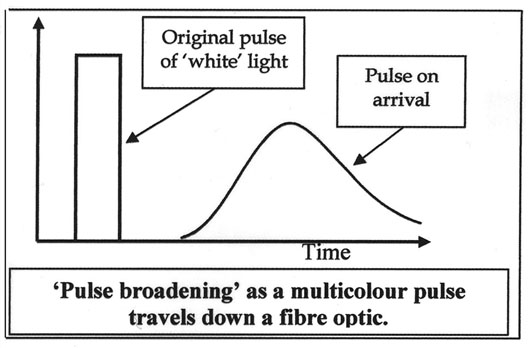
'New Tired Light' Explains Supernovae Light Curve Broadening
When a type Ia supernova goes with a 'bang' they are said to form a 'standard candle' (though not all agree)* ie they all have the same maximum brightness.
A light curve is a graph of Intensity against time and it is said that the time for the light curve of a type Ia supernova to rise and fall increases with redshift, z. In mainstream cosmology this is put forward as 'proof' of an expanding universe. It is explained as relativistic time dilation due to these supernovae whizzing away from us at great speed due to the o que é photoshop.
Big Bangers usually state (wrongly) that in 'spernovae light curve broadening', 'New Tired Light' has no explanation for this and that this one effect 'proves' expansion correct and 'New Tired Light' 'false' - How wrong they are!

When sending digital pulses down a fibre optic, monochromatic light is used as different frequencies travel at different speeds down the fibre. If white light is used, this leads to 'pulse broadening .' In supernovae 'time dilation' muticolour light curves are considered. However, a supernova burst is just a digital pulse and 'pulse broadening' is not taken into consideration when testing 'New Tired Light' models [1].
This produces an effect similar to 'Time Dilation.' Different frequencies of radiation are known to travel through space at different speeds [2] as is shown by gamma ray bursts. All frequencies may well start off at the same time but they will arrive here on Earth at different times - and the greater the redshift, the greater the pulse broadening! Who needs expansion and relativity - 'New Tired Light'.
A video here shows a supernovae event and it clearly shows the colours arriving in order.
Also, 'New Tired Light' explains the problem of Quasar light curves. Quasars have light curves that vary with time and since they have huge redshifts one would expect them to have huge time dilation effects - but they don't. They don't display any effect at all.
This is a problem for the expansionists as relativistic effects would be readily apparent in these curves - more so than in supernovae light curves.
The difference is that in supernovae, the light curves are discrete 'digital' events were Quasar light curves are continuous. In 'New Tired Light' and pulse broadening the effects are only apparent at the beginning and end of the light train. The effects appear in Supernovae light curves but not in the continuous quasar light curves.
Additionally, as the area under both curves are equal, if the pulse is 'broadened' the height is reduced – distant supernovae will be dimmer than expected [3].
This effect is observed and usually put down to 'acceleration.'
* Some say that 'time dilation' in supernovae light curves is just a result of 'malmquist bias.' As we look further and further out at greater and greater redshifts, we are looking at brighter and brighter supernovae (since at greater distances we cannot see the dimmer ones). They describe the effect as brighter supernovae take longer to reach maximum brightness and then dim again so we see broader light curves at greater redshifts.
It should also be noted that when comparing supernovae events at different redshifts we are not comparing like with like. The greater the redshift, the further back in time that event took place. It could well be that, in the past, supernovae just took longer for their light curves to rise and fall.
© Lyndon Ashmore September 2008 Home